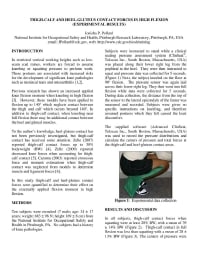Mining Publication: Thigh-Calf and Heel-Gluteus Contact Forces in High Flexion: Experimental Results
Original creation date: August 2009
Authors: JP Pollard
NIOSHTIC2 Number: 20035944
Proceedings of the 32nd Annual Meeting of the American Society of Biomechanics, August 26 - 29, 2009, State College, Pennsylvania. Newark, DE: The American Society of Biomechanics, 2009; :1-2
Thigh-calf and heel-gluteus contact forces act in the anterior direction of the shank, thereby extending the knee and reducing the applied flexion moment. These forces act to stabilize the knee in high flexion and may significantly affect calculations in computational knee models. Traditionally, segment contact forces have been neglected from biomechanical models. The complexity of modeling tissue deformation and pressure distributions may discourage researchers from considering these inputs. However, the magnitude of these forces were shown to be quite large, >30% BW and the moments produced by these contact forces may decrease externally applied flexion moments by as much as 9% BW*Ht. In the future, biomechanical models should account for the thigh-calf and heel-gluteus contact as neglecting these forces may result in erroneous force and moment estimations.

NIOSHTIC2 Number: 20035944
Proceedings of the 32nd Annual Meeting of the American Society of Biomechanics, August 26 - 29, 2009, State College, Pennsylvania. Newark, DE: The American Society of Biomechanics, 2009; :1-2